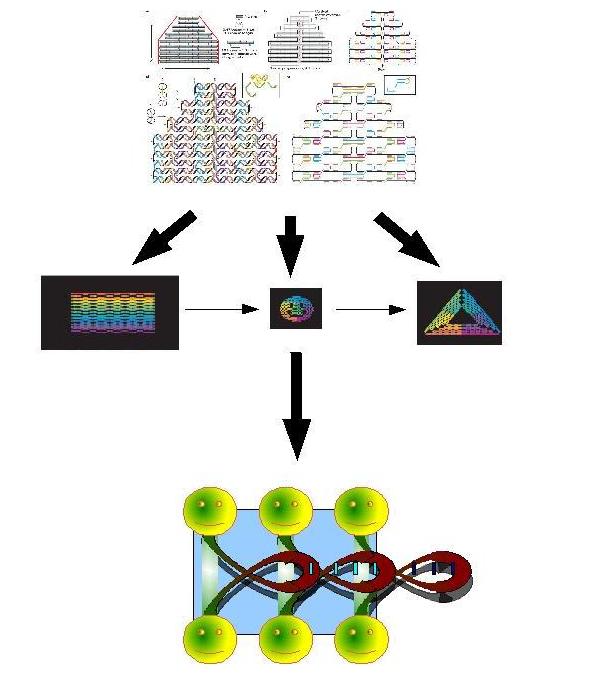Team:Paris/Perspectives
From 2008.igem.org
|
Un petit texte pour expliquer la motivation de cette page ne serait-ce que tout simplement: On this page we report some possible uses of the FIFO device in synthetic applications.
Biosynthetic Bottum-up approachC'est un grand titre de section, où le titre d'une section normale qui manque? A.DNA nanocar factoryThe field of artificial molecular machines and motors is growing at an astonishing rate and is attracting a great deal of interest in nanoscience. REFERENCES Research in the last decade has shown that species made of components like DNA or proteins are attractive candidates. FIFO devices could be applied to coordinate sequences of fabrication or operation steps of nanomachines. For instance, the bottom-up fabrication of DNA nano-cars ! Our aims is to build DNA nanocars by a bottom-up approche! You have to explain what you mean by "produce energy in vitro". What energy does it use? to convert into what other energy? or to use in what way? Also, why in vitro? Do you plan to use our system in cell-free extracts or in living cells? Our system Which system ? Explainis more efficient than a classic system because the FIFO order is very important: the first part will bind by complementarity with part 2 this new part will make the binding site for part 3. Which parts ? Describe. The figure below is too small Fig.1:biosynthesis by sequential expression of 3 DNA origamis If we add after purifications of our car a complementary miRNA to the loop, the competition of the miRNA will open the DNA strands by broking the hydrogen backbound this processe will delivered energy , the instability of the miRNA may make this processe reversible. Please explain more, developing in particular the role of FIFO. To my opinion in this prospective part it does not matter to justify everything, the central point is to present meaningful SCENARIOS for the application of the FIFO In conclusion, these kinds of DNA structures can be suitable, reversible and metastable DNA fuels. How will they move? I doubt that turning their wheels will be of any help... B.Artificial virus factoryWe can also produce a lot of differentes kinds of self-assembly structures like virus for example,HIV: No, you can not produce... You can say (possibly)... The FIFO device provides also a circuit useful to coordinate the self-assembly of molecular structure. A possible canevas for the production of synthetic virus?
Fig2: genetic organization of HIV virus HIV can be produce by sequential expression of 3 genes gag,env and pol (Fig.2)those genes will be cleaved by protease P10 and than the subunits of the virus will self-assembled into mature virus. In our case, we will expressed gag p10 and finaly Env (without Pol to avoid pathogenicity) the FIFO in this case will be essential. If you ask us why? For 3 main reasons :
Metabolic engineering of polyhydroxyalkanoate biosynthesis pathwaysHuman overpopulation combined with the current lifestyle urges the rational, efficient, and sustainable use of natural resources to produce environmentally friendly plastic materials such as polyhydroxyalkanoic acids (PHAs), whose production/degradation cycle reduces undesirable wastes and emissions. Our study is a new metabolic strategy to generate PHA-hyperproducer strains, that have the properties to be a sequential metabolic pathway, we believe the sequential expression may increases the production of purified PHA. Our strategy consists on replacing the RFP,CFP and YFP genes by the PhaA ,PhaB and PhaC genes in our final system (containing oscillation,FIFO,synchronisation modules). This strategy is more efficient than a constitutive activation for 3 main reasons:
Again, you cannot just state this boldly without constructing an argument. You never explain why your system is better than simply expressing all the genes continuously at a lower level More generally, on this whole page: We don't expect you to give very detailed projects. You just need to give simple ideas for which the interest of the FIFO seems obvious (or at least you need to try making it seem obvious). We are not so much interested in the precise mechanisms or genes involved, but rather in the principles that make your projects interesting. Bibliography
Paul W. K. Rothemund
Paul W. K. Rothemund
Suvir Venkataraman, Robert M. Dirks, Paul W. K. Rothemund, Erik Winfree, Niles A. Pierce.
Georg Seelig, Bernard Yurke, Erik Winfree. |
 "
"



